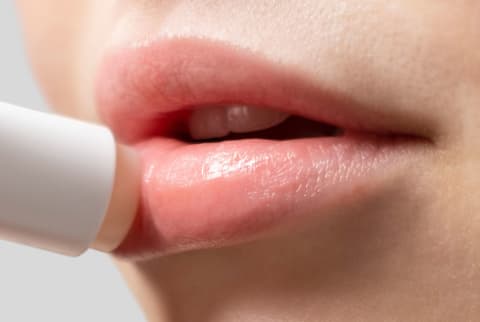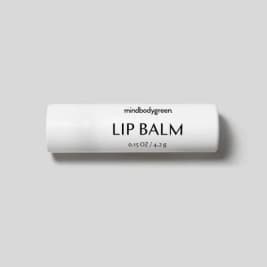The Best Lip Balm Formulas Share This Characteristic — Does Your Fave?


For a relatively small area of overall skin real estate, the lips garner a lot of attention in the beauty world. From innovative plumping technology to just-launched makeup items galore, there are many products to sift through in the hunt for healthy, hydrated lips. And while new products are certainly exciting, they mean nothing without establishing the basics.
And in the world of lip care, the daily essential lip balm reigns supreme. Most folks I know—myself included—have several stashed away in various purses, gym bags, bathroom drawers, and littered sporadically around the house. (Isn't it such a small joy to find an old favorite tucked away in a coat pocket?) And the lip balms that are the most coveted, and last the test of time, have one thing in common in their formula.
Here, the inside scoop on finding a daily lip balm that will actually keep your lips hydrated all day long.
The best lip balms use these in their formulas.
You're not imagining it: Some lip balms can leave your skin drier than before. Most of us know the frustration of applying a formula, only to have to reach for it moments later because the skin already feels parched.
However, the right lip balm will leave your skin feeling comforted for hours (reapplying throughout the day is normal—especially if you're drinking hot liquids, eating spicy food, or licking your lips). And balms that are able to achieve this can do so because they use a blend of humectants, emollients, and occlusive ingredients—like in mindbodygreen's lip balm.
The new and improved formula uses a blend of ingredients that instantly softens the skin and deeply hydrates, keeping them feeling comfortable all day long. I'm absolutely obsessed with our new formula and have no less than five tubes in my arsenal at any given moment. I'm particularly fond of the not shiny yet never dull sheen the formula imparts.
Here, what the best, most high-quality balms do in their formulas.
Humectants.
"Humectants are basically 'water magnets,'" board-certified dermatologist Ava Shamban, M.D., founder of SKINFIVE, told us about the class of ingredients. "They work to help pull moisture from the air into the upper layer of your skin to keep the skin cells hydrated, plump with a firmness and bounce."
However, when left to their own devices, humectants can actually end up dehydrating the skin. This is because they're indiscriminate about where they pull in water. For example, when it's humid, they can pull it from the air around you. But if you're in an arid environment or spend a lot of time indoors exposed to AC or heaters, then they'll actually pull it from the deeper layers of the skin, making the skin overall more dehydrated.
This is why humectants should really be paired with occlusives and emollients—either in the same formula or layered together.
For ease, here are some popular humectants to look out for on the ingredient list:
- Glycerin
- Aloe
- Hyaluronic acid (or sodium hyaluronate, a smaller form often used for the lip area)
Emollients
Emollients are a class of ingredients that soften and condition the skin—they sink into the cracks, helping nourish and heal the barrier. These are the ingredients that help the formula feel great upon application and help the skin feel comforted.
Emollients come in many different varieties—from plant-based oils and butters to fatty acids, ceramides, and synthetically made oils. Your specific preferences, skin needs, and use case will likely influence which ingredients you'll look for. Here are some great options to use for your lips:
- Moringa seed oil
- Castor oil
- Coconut oil
- Ceramides
- Honey (not vegan)
Occlusives
Finally, the balm needs thick ingredients that can act as a seal—trapping in all the moisture underneath and offering a barrier of protection throughout the day. You may have become familiar with the concept of occlusives because of the recent rise in popularity of skin slugging, a practice by which folks slather on a thick formula as part of their last step before bed (with the idea that it will stop nighttime transepidermal water loss). And while that's taking occlusive ingredients to their most extreme, it's actually good practice to use somewhat occlusive formulas in your day-to-day life.
And certainly they should be in your lip balm. Here are a few of our favorites:
- Shea butter
- Sunflower seed wax
- Beeswax (not vegan)
If you're a regular ingredient list reader, you may notice a very popular type of occlusive is missing from the list: mineral oils, petroleum jelly, and petrochemicals. They're commonly used for a few reasons: They're inexpensive, lend products a smooth sensorial experience, and are molecularly large so they sit on the skin, acting as an occlusive. However, for environmental reasons, many folks have started choosing not to use them as much as possible.
The takeaway.
You may think a good lip balm is simple—and while it should be effortless to use, the formula itself is often a bit complex. In mindbodygreen's lip balm, we blended together shea butter, sunflower seed wax, sodium hyaluronate, castor oil, moringa seed oil, and several other high-quality ingredients. The final outcome is a balm that nourishes with every swipe and leaves you satisfied throughout the day.

Alexandra Engler is the beauty director at mindbodygreen and host of the beauty podcast Clean Beauty School. Previously, she's held beauty roles at Harper's Bazaar, Marie Claire, SELF, and Cosmopolitan; her byline has appeared in Esquire, Sports Illustrated, and Allure.com. In her current role, she covers all the latest trends in the clean and natural beauty space, as well as lifestyle topics, such as travel. She received her journalism degree from Marquette University, graduating first in the department. She lives in Brooklyn, New York.

